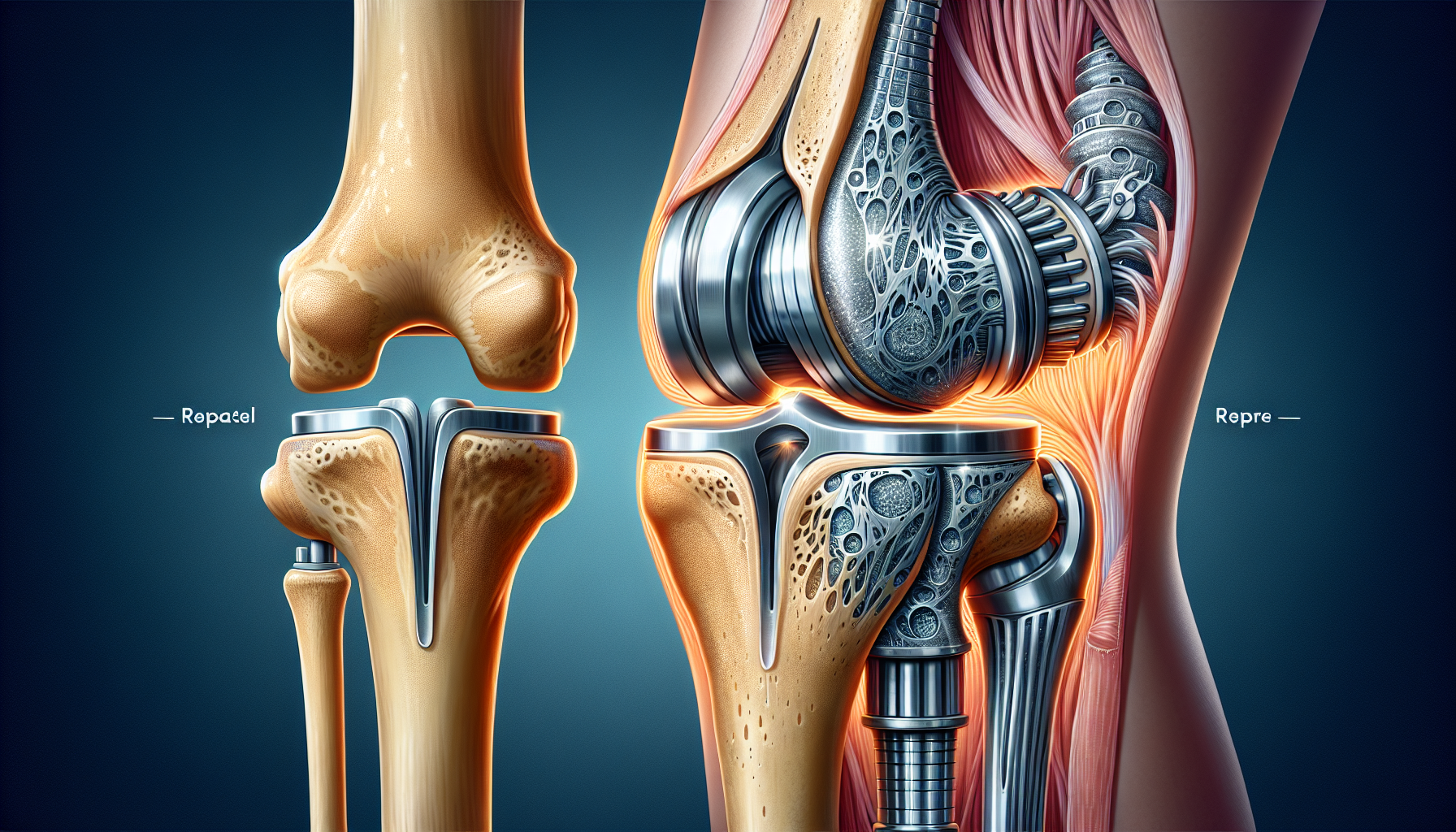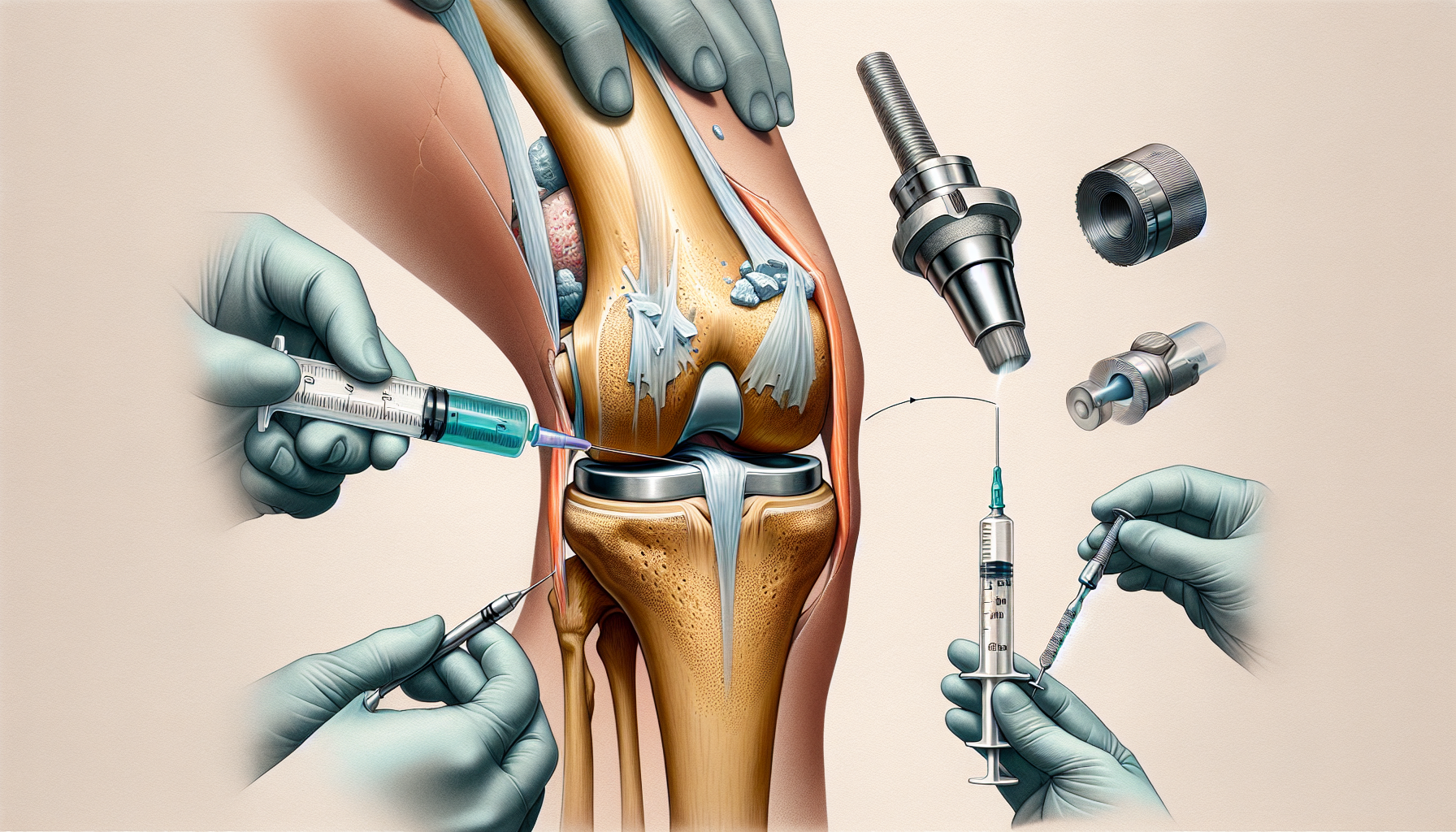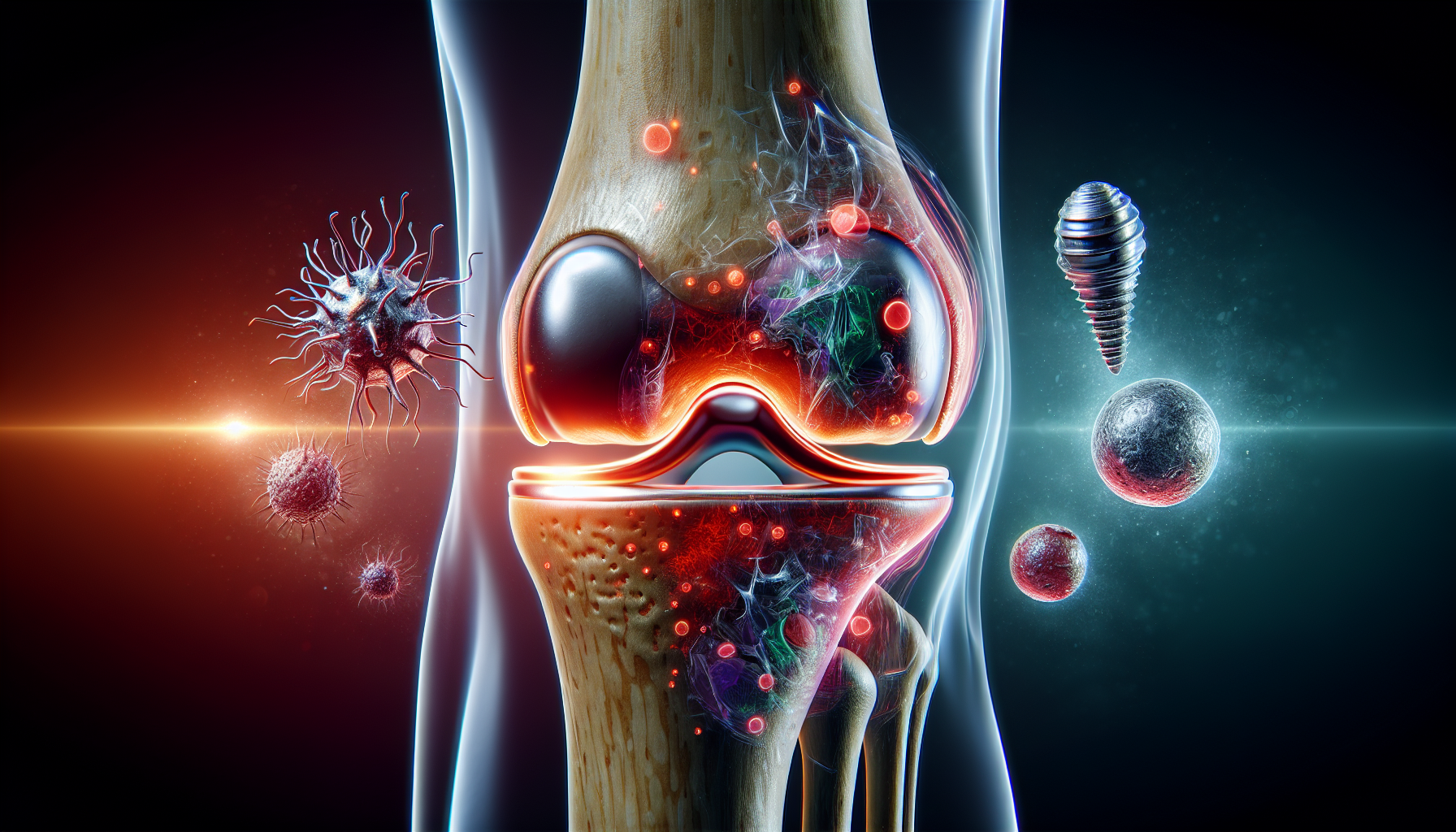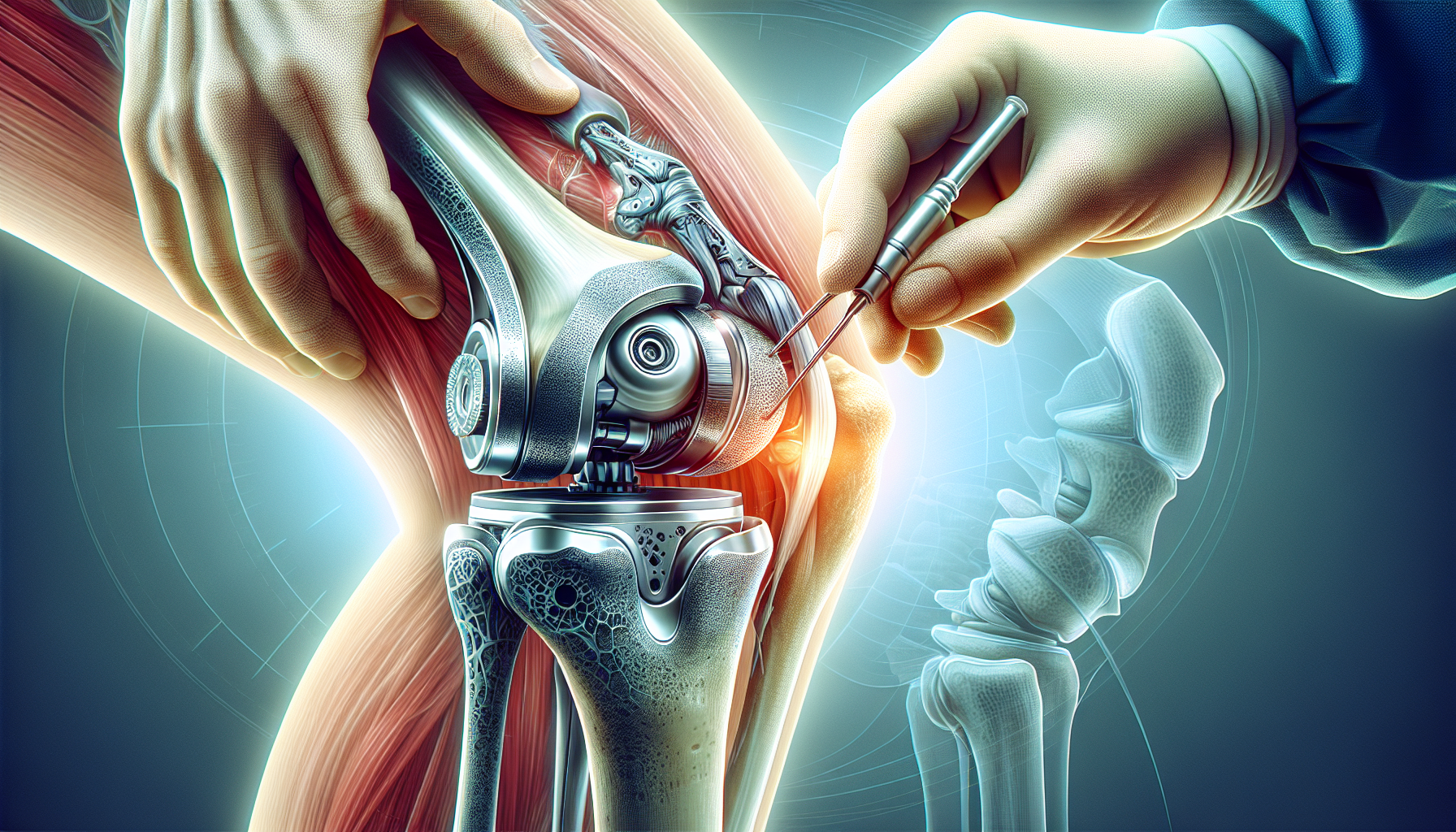What is knee arthroplasty? Knee arthroplasty, or knee replacement surgery, is a procedure to relieve pain and restore function in a diseased knee joint. It involves replacing damaged parts of the knee with artificial components. In this article, you will learn about the types of knee arthroplasty, why it’s done, the surgical process, and what to expect during recovery.
Key Takeaways
- Knee arthroplasty, including total and partial knee replacements, is a highly effective surgical procedure for alleviating severe knee pain and improving mobility, with prostheses lasting 15 to 20 years.
- There are two main types of knee arthroplasty: Total Knee Replacement (TKR), which involves replacing the entire knee joint, and Partial Knee Replacement (PKR), which targets only the damaged compartment of the knee.
- Preoperative assessments, careful surgical techniques, ongoing innovations, and vigilant postoperative care are essential for minimizing risks and complications and ensuring successful recovery from knee arthroplasty.
1 Understanding Knee Arthroplasty
Knee arthroplasty, also known as total knee arthroplasty, stands as a beacon of hope for those burdened by the relentless ache of knee arthritis or injury. This procedure, which has evolved into a refined art of orthopaedic surgery, involves the meticulous replacement of knee joint surfaces with specialized knee implants. The ultimate aim? To bid farewell to the distress of knee pain and welcome a new era of mobility. Picture a healthy knee with a seamless range of motion, free from the chains of arthritis or injury-induced discomfort — that’s the promise of knee arthroplasty.
The journey towards a new knee begins with a careful assessment of the knee’s condition. Factors such as the extent of damage from knee osteoarthritis and an individual’s lifestyle play pivotal roles in suggesting knee replacement as the path forward. Once the decision is made, patients can envision a life where activities like walking or climbing stairs are no longer marred by pain, thanks to the significant pain relief and improved function that most knee replacements offer. With the longevity of these knee prostheses spanning 15 to 20 years, recipients can look forward to an extended period of rejuvenated knee motion.
Types of Knee Arthroplasty

Prior to starting your journey through knee replacement surgery, getting familiar with the available options is crucial. There are two primary types of knee arthroplasty: Total Knee Replacement (TKR) and Partial Knee Replacement (PKR). Each route is tailored to the unique landscape of knee damage and patient needs, ensuring the best fit for a successful outcome.
Total Knee Replacement (TKR)
Total knee replacement surgery, a procedure that has restored the stride of millions since its inception in 1968, stands as a testament to the marvels of modern orthopaedic surgery. In this joint replacement procedure, the entire knee joint is reinvented, with the surgeon removing damaged cartilage and bone to replace them with state-of-the-art knee implants. As the recipient of a procedure knee replacement surgery, one can expect a restored range of motion and the ability to engage in daily activities without the previous hindrance of knee pain.
The procedure itself is a symphony of precision and expertise, typically lasting 1 to 2 hours. The surgeon crafts a new knee by:
- Attaching a metal femoral component to the thigh bone
- Attaching a tibial component to the shin bone, both secured with bone cement
- Resurfacing the patellar component with plastic to ensure a harmonious fit, if needed.
The TKR has become a common narrative in the lives of many, with over 700,000 procedures performed annually in the U.S., each story woven with threads of regained mobility and freedom from pain.
Partial Knee Replacement (PKR)
Partial knee replacement surgery, also known as unicompartmental knee arthroplasty, is a chapter best suited for those whose knee arthritis narratives are confined to one compartment of the knee. This less invasive option replaces only the area ravaged by arthritis, preserving as much of the knee’s original structure and function as possible. It’s an intimate tale of restoration, where only the damaged chapters are rewritten, leaving the rest of the knee’s story untouched.
In PKR, the surgical spotlight focuses solely on the affected compartment, whether it be the inner, outer, or kneecap section. By targeting the specific area of knee pain and dysfunction, PKR offers:
- Faster recovery
- Fewer risks compared to total knee replacement
- Precise and personalized approach to knee surgery
- Alignment with the natural anatomy
- Retention of as much of the healthy knee as possible for seamless integration of the new knee implant.
Indications for Knee Arthroplasty
Opting for knee arthroplasty is a significant decision that requires careful thought. It is a culmination of narratives where knee pain and disability play the antagonists, often due to the wear and tear of osteoarthritis or the inflammation of rheumatoid arthritis. However, this decision is also guided by other plot twists such as post-traumatic arthritis, which can emerge from the aftermath of a knee injury like fractures or ligament tears, and avascular necrosis, where compromised blood flow leads to bone tissue demise.
When knee pain becomes the dominant theme, limiting the simple pleasures of daily life, and when nonsurgical treatments like medications and physical therapy no longer suffice, knee arthroplasty enters the story as a potential protagonist. The indications for this surgical intervention are clear:
- Severe pain due to arthritis that dictates the narrative of one’s life
- Chronic knee inflammation resistant to the supporting roles of medication
- Knee deformity that alters the course of movement.
Preoperative Considerations
Before commencing knee replacement surgery, several preoperative aspects need consideration to pave the way for success. It begins with a thorough medical evaluation to ensure the patient’s readiness to undergo the transformative procedure. A comprehensive preoperative assessment includes:
- A thorough medical history
- A physical examination
- Blood tests
- Diagnostic tests, such as X-rays or MRI scans
These steps are essential in determining the patient’s overall health and identifying any potential risks or complications that may arise during or after the surgery.
However, the preoperative script includes more than medical evaluations. It involves discussions about medications, possible allergies, and any underlying medical conditions that could influence the surgical outcome. For older men with prostate disease or patients with a history of urinary infections, a urological evaluation is recommended to mitigate any associated risks. Completing any major dental work is also advised to reduce the risk of postoperative infection.
This prelude ensures that when the moment of surgery arrives, the patient and the medical team are ready to perform an opus of restoration.
The Surgical Procedure

The surgical procedure of knee arthroplasty is akin to an artist sculpting a masterpiece. It commences with the patient under regional anesthesia, embarking on a journey towards a new lease of life without the sensation of pain. A calculated incision unveils the knee joint, setting the stage for the surgeon to remove the damaged cartilage and bone and begin crafting the new knee.
The artistry involves attaching metal and plastic parts to the bones with precision, ensuring the knee implant perfectly mirrors the function of a natural knee. The surgeon’s movements are deliberate, bending and flexing the knee to guarantee the knee prosthesis aligns correctly, promising a future where the knee bends and moves as it was always meant to. Once the components are affirmed in their rightful places, the incision is closed, heralding the end of the procedure and the beginning of a rejuvenated chapter.
Postoperative Care and Recovery

The knee arthroplasty journey extends beyond the final suture, progressing into the vital postoperative phase. Pain management is paramount in this act, employing medications and techniques to relieve pain and facilitate an active role in physical therapy. The protagonist in this recovery period is physical therapy, which commences as early as 24 hours post-surgery, setting the rhythm for regaining strength and motion.
As the days unfold, the symphony of recovery plays on, with exercises to rejuvenate the leg muscles and promote blood flow, including those focused on foot and ankle movement. Patients may need assistance from a physical therapist with daily activities as they navigate this transition, using supportive devices to prevent falls and maintain balance.
The crescendo of this journey is reached when the patient resumes normal activities, a testimony to the successful union of medical expertise and the resilience of the human spirit.
Risks and Complications

Like any surgical process, knee arthroplasty carries potential risks and complications. Despite high success rates, it’s important to recognize potential complications like infection and blood clots that could hinder the recovery process. Infections can range from superficial to deep within the joint, with the latter possibly necessitating further surgical intervention. Blood clots, the most common complication, pose a significant risk and require vigilance to detect the early signs of their treacherous journey.
Implant problems, such as loosening or wear, and the rare occurrence of nerve or blood vessel injuries, are chapters that surgeons strive to avoid through meticulous planning and execution. The script of knee arthroplasty includes preventive measures like prophylactic antibiotics and anticoagulant therapy to reduce the likelihood of these complications, ensuring the patient’s journey to recovery is smooth and unencumbered by unforeseen plot twists.
Innovations in Knee Arthroplasty
Ongoing advancements in knee arthroplasty continue to redefine the course of knee replacement surgery. Innovations such as minimally invasive techniques have emerged, minimizing trauma to muscles and allowing for a more rapid recovery. The introduction of computer-assisted and robotic-assisted surgery has elevated precision to new heights, guiding surgeons through the complex landscape of the knee with unprecedented accuracy.
Custom-fit implants tailored to the individual’s anatomy promise a future where knee replacements feel more natural than ever before. The first knee replacement using augmented reality (AR) assistance, performed in 2020, marks the dawn of a new chapter in surgical technology, one that blends the physical and digital worlds to enhance outcomes. These innovations not only refine the technical aspects of the surgery but also promise a more personalized approach to patient care, ensuring that each knee arthroplasty story is as unique as the individual it’s written for.
Cost and Insurance Coverage
The financial aspect of knee arthroplasty is complex, with costs varying based on several factors, including the surgeon’s fee and post-operative care. In the United States, the cost of total knee replacement surgery hovers around $20,000, but this figure can fluctuate significantly based on individual circumstances and additional medical services required. Insurance coverage can greatly alleviate the financial burden, with most insurance plans, including Medicare, covering a substantial portion of knee arthroplasty expenses.
For those without insurance or adequate coverage, hospitals may offer discounts or payment plans to make the procedure more accessible. It’s a conversation worth having with healthcare providers to understand the full spectrum of costs and coverage before embarking on this life-enhancing journey.
Understanding the financial aspects of knee arthroplasty is as important as the medical preparations, setting the stage for a smooth and stress-free recovery.
Summary
Knee arthroplasty is a journey of transformation, liberating individuals from the constraints of knee pain and immobility. Through the intricate process of total or partial knee replacement, patients are gifted a chapter of renewed movement and freedom. With careful preoperative planning, skillful execution, and dedicated postoperative care, knee arthroplasty promises a high success rate and improved quality of life. Innovations in surgical techniques continue to push the boundaries of what’s possible, ensuring that each patient’s story of recovery is one of hope, resilience, and rejuvenation.
Frequently Asked Questions
How long do knee implants from a knee arthroplasty typically last?
Knee implants from a knee arthroplasty typically last 15 to 20 years, providing recipients with an extended period of improved knee function and pain relief.
Can I return to high-impact activities after knee replacement surgery?
After knee replacement surgery, it’s best to avoid high-impact activities to preserve the durability of the knee implants. Instead, focus on low-impact exercises to stay fit and maintain joint health.
What are the main reasons for undergoing knee arthroplasty?
The main reasons for undergoing knee arthroplasty are to relieve severe knee pain, often caused by arthritis, and to restore mobility and function to the knee joint.
Are there any new surgical techniques for knee replacement surgery?
Yes, there have been several advances in knee replacement surgery, including minimally invasive techniques, computer-assisted surgery, robotic-assisted surgery, and custom-fit implants, all aimed at improving outcomes and recovery times. These advancements offer personalized solutions and quicker recovery for patients.
How do I know if I need a total knee replacement or a partial knee replacement?
The extent of knee damage and which compartments of the knee are affected will determine whether a total knee replacement or a partial knee replacement is more suitable. A thorough evaluation by an orthopedic surgeon will help in making this decision.





 William D. Murrell, MD
William D. Murrell, MD Thomas B. Evely, DO
Thomas B. Evely, DO Clifford Voigt, MD
Clifford Voigt, MD Karthikeyan Chinnakkannu, MD
Karthikeyan Chinnakkannu, MD Max N. Seiter, MD
Max N. Seiter, MD Demetris Delos, MD
Demetris Delos, MD Lauren M. Fabian, MD
Lauren M. Fabian, MD